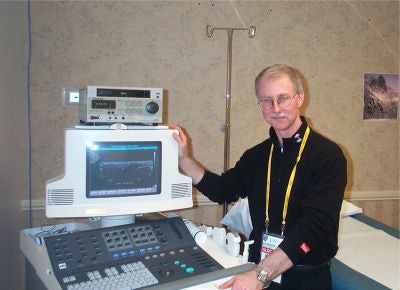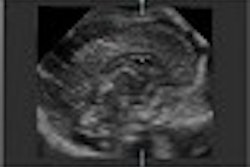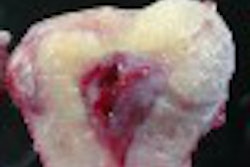
SALT LAKE CITY - The name Jim Shea Jr. is now undeniably associated with the sport of skeleton. When people think figure skating wunderkind, it's a good bet Sarah Hughes comes to mind.
At the Olympic Polyclinic, musculoskeletal ultrasound means Dr. Bill Middleton. In fact, the professor of radiology from the Mallinckrodt Institute in St. Louis was referred to as "the ultrasound guy" by many of his colleagues. Middleton doesn’t seem to mind being the champion of bone and joint ultrasound.
"There are unique things that you can learn from ultrasound. We know that ultrasound, in our hands (at Mallinckrodt), is a little bit better for rotator cuff problems. It’s very good for tendon disease in general and it’s very good at evaluating masses in the extremities and, to a certain extent, ligaments," he said.
 |
| Mallinckrodt radiologist Dr. Bill Middleton is a champion of musculoskeletal ultrasound. |
Other advantages of the modality include its lower cost, its ease on the patient, and its ability to pinpoint superficial injuries with high-frequency transducers for high-resolution images, Middleton noted.
In one instance at the Polyclinic, ultrasound bested MRI, in Middleton’s estimation. He cited the case of a ski jumper who was experiencing pain at the point where his boot hit the top of his shin.
"Clinically, there was a little swelling and a lot of pain, but they weren’t sure if it was a muscle tear or some sort of bony abnormality. It was clear from the ultrasound that the muscle was entirely normal," Middleton said. "There was a lot of swelling in the superficial soft tissues that accounted for what he was feeling. We also had a little bit of periosteal reaction in the underlying tibia, and a little bit of subperiosteal fluid of the tibia. That was just plain as day on ultrasound."
"Then we did his MRI and, knowing that we had those findings on the ultrasound, you could see it on the MRI," he said. "But it would have been something that would be easy to de-emphasize on the MRI. The MRI shows you everything, and you don’t really focus on a particular area so it doesn’t look as obvious."
Not that Middleton is discounting musculoskeletal MRI completely. Agreement between MR and sonographic scans at the Polyclinic has been good, and MR certainly has its strong points, particularly for deep-tissue imaging. "We did a nice case this morning on a talofibular ligament that was very abnormal and very obvious on the ultrasound. It correlated nicely with the MR exam," he said, adding that MR is also better for scanning large areas of the body.
Middleton revealed that, when he was invited to work at the Polyclinic, he had to seriously consider whether to accept, as the deadline was approaching for a textbook he is writing.
"When Julia (Crim) asked me, I had to decide ‘Do I want to do this because I’m in the middle of crunch time for the book?’ But it’s such a unique opportunity," he said. "I decided I’ll just use all of my spare time to work on the chapters."
The topic of Middleton’s forthcoming tome? Ultrasound, of course.
By Shalmali Pal
AuntMinnie.com staff writer
February 24, 2002
Copyright © 2002 AuntMinnie.com



















